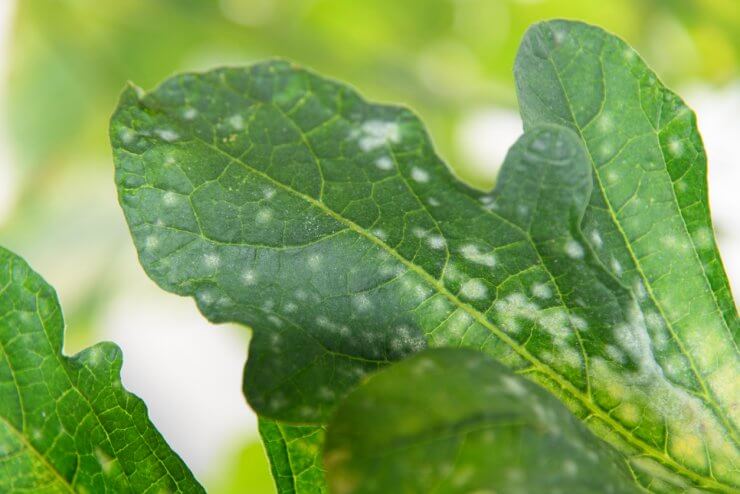
Melon green leaf destroyed by powdery mildew
Like all food crops, melon plants are susceptible to various fungal diseases. Your greatest weapons against these are best planting practices, which help prevent disease in the first place.
This is especially important, as there are no fungicides approved for home use for many diseases.
These best practices are aimed at producing strong, healthy plants that can withstand disease, and at avoiding situations that contribute to the development of disease. They involve keeping plants clean, dry, and undamaged.
Watering: Water your melon plants deeply about once a week (check the soil for dryness). Do not over-water; melon plants hate having wet feet! Soggy soil invites disease.
Mulch: Mulch can help with water retention—but be vigilant and check for insect or fungal activity.
Other best practices include:
- Buy healthy, disease-free plants from reputable sources.
- Plant your melons in full sun.
- Wait until all danger of frost is past, and the ground is sufficiently warm.
- Plant in sites with good drainage; if planting in open ground, choose a higher spot for better drainage.
- Remove infected foliage and fruit.
Common melon diseases
Here are some of the usual culprits that might infest your melon plants. Remember, it’s important to remove diseased fruit, flowers, and leaves to prevent the spread of disease once it’s found its way onto your plant.
Anthracnose
Cause: Fungus
Symptoms:
- leaves turn yellow at the tips, eventually turning brown all around
- browned, dying leaves
- dark, sunken lesions on fruit and/or stems
How it Spreads:
- spores spread by rain, splashing water
- wind
Treatment:
- remove all infected parts
- clear ground of leaf and twig litter
- apply liquid copper fungicide to reduce recurrence
Prevention:
- prune plant to provide good air circulation and access to sunlight
- provide proper water and fertilizer
Downy Mildew
Cause: Fungus
Symptoms:
- starts as lesions on the upper surfaces of older leaves
- downy growths on underside of leaves, ranging from light gray to deep purple
- lesions can spread and join, leaving fruit exposed to sunscald
How it Spreads:
- splashing water (rain, irrigation) disturbs spores
- wind
Treatment:
- destroy infected fruits
- prune low-hanging leaves to provide better air flow
Prevention:
- spray with potassium phosphite or fosetyl-Al in late July and again in October if fungus persists
- homemade fungicides
- grow disease-resistant varieties
- choose planting sites with good air movement and no shade
Gummy Stem Blight
Cause: Fungus
Symptoms:
- sudden death of a vine or the entire plant
- oozing cankers on the vines
- long, water-soaked areas on the stems
- brown or black spots on older leaves
How it Spreads:
- spores spread by rain, splashing water
- movement through garden
- wind
Treatment:
- use drip irrigation rather than overhead watering to keep leaves from getting overly wet
- liquid copper fungicide, if infection is severe
- remove and discard infected parts
Prevention:
- always water the soil around the plant; avoid wetting leaves
- ensure plant is getting adequate water, light, and fertilizer
- liquid copper fungicide
- crop rotation: do not plant cucurbits in the same area for at least two years
Powdery Mildew
Cause: Fungus
Symptoms:
- white, powdery patches on vines and older, shaded, lower leaves
- infected leaves shrivel and die
- heavy mildew infections can stunt a plant’s growth and cause early leaf-fall
How it Spreads:
- splashing water (rain, irrigation) disturbs and disperses spores
- wind
Treatment:
- remove and destroy infected plant material immediately
Prevention:
- liquid copper fungicide
- if necessary, sulfur-based fungicide
- plant disease-resistant varieties
- increase air flow through plants
- check plants daily
- remove plant debris
This is a sampling of the diseases that may plague your melons. The key to prevention is to maintain good air flow in your plants and to keep the leaves from getting overly wet.
Here are some of the other diseases that may affect your melon crop. Check with your local extension center for diagnosis and advice on controlling outbreaks:
- Alternaria Leaf Spot
- Bacterial Wilt
- Black Rot
- Cucumber Mosaic Virus
- Damping Off
- Fusarium Fruit Rot
- Scab
- Seed Rot
- Phytophthora Blight
- Pythium Fruit Rot
Which diseases have you had to treat on your melon plants? Please tell us how you prevent and handle diseases. If you’ve spotted other symptoms on your melon plants that are not mentioned here, let us know what you discover.


 Previous
Previous

